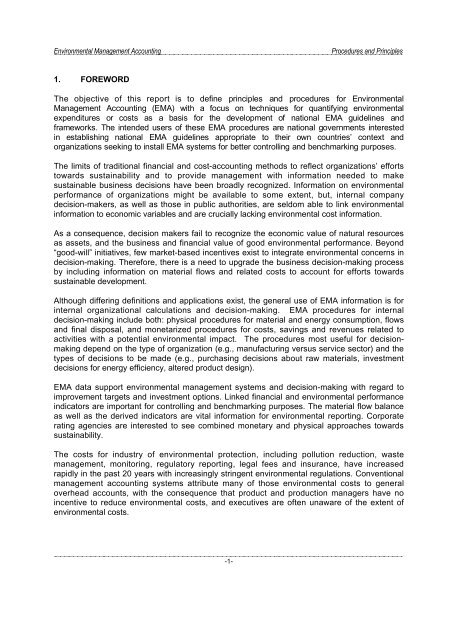Environmental Management Accounting Procedures and Principles
Environmental Management Accounting Procedures and Principles
Environmental Management Accounting Procedures and Principles
Create successful ePaper yourself
Turn your PDF publications into a flip-book with our unique Google optimized e-Paper software.
<strong>Environmental</strong> <strong>Management</strong> <strong>Accounting</strong><br />
<strong>Procedures</strong> <strong>and</strong> <strong>Principles</strong><br />
1. FOREWORD<br />
The objective of this report is to defi ne pr inci ples <strong>and</strong> proc edur es for Env ir onmental<br />
<strong>Management</strong> Ac counti ng (EMA) wit h a focus on techniques for quanti fy i ng envi ronment al<br />
expendi t ur es or cos t s as a basi s for the dev el opment of nati onal EMA gui del ines <strong>and</strong><br />
f ramewor ks . The int ended us er s of these EMA pr oc edures are nati onal gover nments inter es ted<br />
i n es tabli shi ng nat i onal EMA gui deli nes appr opri ate to their own count ri es’ cont ex t <strong>and</strong><br />
organiz ati ons s eeki ng to inst al l EMA sy st ems f or bett er cont r ol li ng <strong>and</strong> benchmar ki ng purpos es.<br />
The limits of traditional financial <strong>and</strong> cost-accounting methods to reflect organizations’ efforts<br />
towards sustainability <strong>and</strong> to provide management with information needed to make<br />
sustainable business decisions have been broadly recognized. Information on environmental<br />
performance of organizations might be available to some extent, but, internal company<br />
decision-makers, as well as those in public authorities, are seldom able to link environmental<br />
information to economic variables <strong>and</strong> are crucially lacking environmental cost information.<br />
As a consequence, decision makers fail to recognize the economic value of natural resources<br />
as assets, <strong>and</strong> the business <strong>and</strong> financial value of good environmental performance. Beyond<br />
“good-will” initiatives, few market-based incentives exist to integrate environmental concerns in<br />
decision-making. Therefore, there is a need to upgrade the business decision-making process<br />
by including information on material flows <strong>and</strong> related costs to account for efforts towards<br />
sustainable development.<br />
Although differing definitions <strong>and</strong> applications exist, the general use of EMA information is for<br />
internal organizational calculations <strong>and</strong> decision-making. EMA procedures for internal<br />
decision-making include both: physical procedures for material <strong>and</strong> energy consumption, flows<br />
<strong>and</strong> final disposal, <strong>and</strong> monetarized procedures for costs, savings <strong>and</strong> revenues related to<br />
activities with a potential environmental impact. The procedures most useful for decisionmaking<br />
depend on the type of organization (e.g., manufacturing versus service sector) <strong>and</strong> the<br />
types of decisions to be made (e.g., purchasing decisions about raw materials, investment<br />
decisions for energy efficiency, altered product design).<br />
EMA data support environmental management systems <strong>and</strong> decision-making with regard to<br />
improvement targets <strong>and</strong> investment options. Linked financial <strong>and</strong> environmental performance<br />
indicators are important for controlling <strong>and</strong> benchmarking purposes. The material flow balance<br />
as well as the derived indicators are vital information for environmental reporting. Corporate<br />
rating agencies are interested to see combined monetary <strong>and</strong> physical approaches towards<br />
sustainability.<br />
The costs for industry of environmental protection, including pollution reduction, waste<br />
management, monitoring, regulatory reporting, legal fees <strong>and</strong> insurance, have increased<br />
rapidly in the past 20 years with increasingly stringent environmental regulations. Conventional<br />
management accounting systems attribute many of those environmental costs to general<br />
overhead accounts, with the consequence that product <strong>and</strong> production managers have no<br />
incentive to reduce environmental costs, <strong>and</strong> executives are often unaware of the extent of<br />
environmental costs.<br />
-1-




